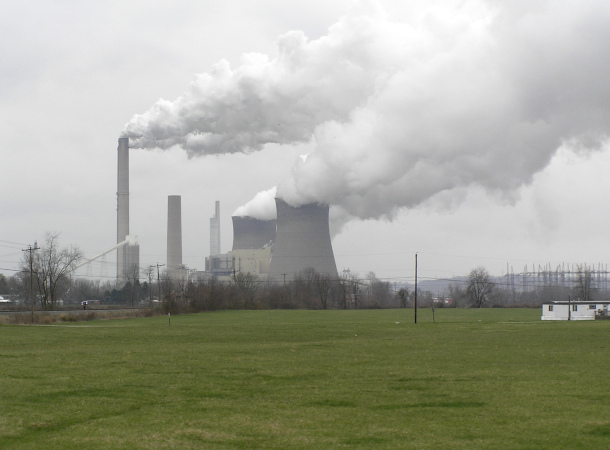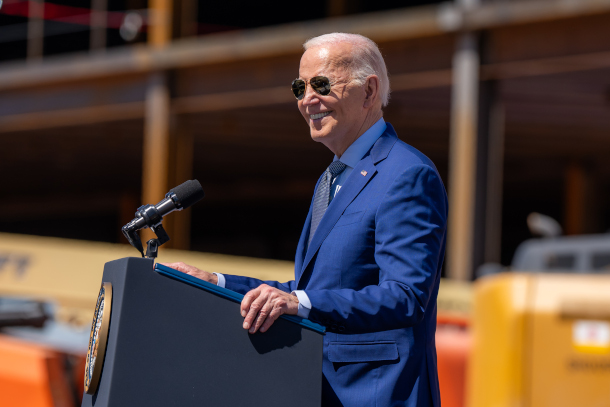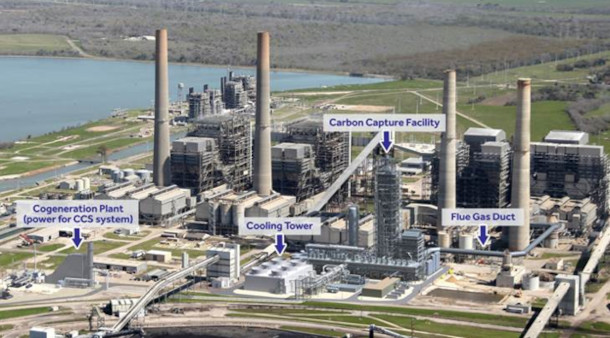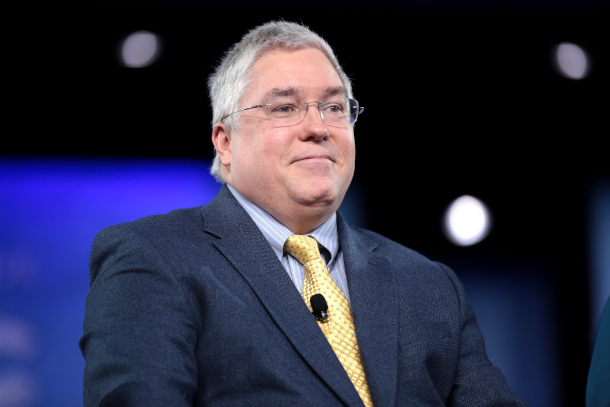New Power Plant Rules
Air Date: Week of May 10, 2024

Existing coal-fired power plants and new gas-fired power plants will be subject to the updated climate pollution standards set by the EPA. There are also a series of regulations that deal with other pollutants like wastewater and coal ash. (Photo: peggydavis66, Flickr, CC BY-SA 2.0)
To replace the Clean Power plan the Obama Administration failed to get past the courts the EPA published new rules for existing coal plants and new gas power plants that tighten standards for mercury emissions, wastewater, and coal ash and also curb coal plant CO2 emissions over time. Living on Earth’s Paloma Beltran discusses with the rule with David Doniger, a former White House and EPA clean air official and attorney for the Natural Resources Defense Fund.
Transcript
O’NEILL: From PRX and the Jennifer and Ted Stanley Studios at the University of Massachusetts Boston, this is Living on Earth. I’m Aynsley O’Neill.
BELTRAN: And I’m Paloma Beltran.
To replace the Clean Power Plan the Obama administration failed to get past the courts, the EPA has published new rules to fight global warming gases and other pollutants from existing coal-fired power plants and new gas ones. These updated rules tighten standards for the plants’ mercury emissions, wastewater, and coal ash. And coal power plants must significantly curb their CO2 emissions over time. Carbon capture and storage technology may be one way to meet those goals, with the help from the Inflation Reduction Act. But critics still question the viability and safety of CCS. Here to discuss the implications of the new EPA mandates is David Doniger, a former clean air expert for the White House and EPA, and now lead global warming attorney for the Natural Resources Defense Council. David, welcome back to Living on Earth!
DONIGER: Thank you. It's good to be back here.
BELTRAN: So the current administration's emissions reduction targets include reaching around 100% carbon pollution-free electricity by 2035, and achieving a net zero emission economy by 2050. To what extent will these new rules put us on track to reach those goals? And how big of a deal is this?
DONIGER: Well, this is a very big deal. With these rules, by 2035, EPA is projecting that the power sector will be about 75% less polluting than it was at its peak in 2005. It's not 100%. But it's a good solid step in the right direction. We have to do more, but this is a very big step in the right direction.
BELTRAN: And what are the potential public health benefits of these new rules?
DONIGER: Well, these are aimed at carbon dioxide. Carbon dioxide drives the warming of our planet. The warming of our planet is causing terrible storms, heat waves, stronger hurricanes, stronger floods, the oceans are hotter than they've ever been. And that's expected to drive really a bad hurricane season this year. So these events kill people, they hurt people, they make them sick, those are direct effects on our health.

The Biden-Harris Administration has set a goal of reaching 100% carbon-pollution-free electricity by 2035. The EPA predicts the new rules will get the country 75% of the way to that goal. (Photo: The White House, Flickr, CC BY-SA 2.0)
BELTRAN: And how will those plants actually meet these emission targets? What pathways do they have available for them to meet those goals?
DONIGER: Well, the way the Clean Air Act works, and the way the Supreme Court confirmed in 2022 that it works, is it directs EPA to set what are called performance standards, an emission rate, and the emission rate is based on the best system of emission reduction, the best technology. In the case of power plants, the most effective technology is to capture the carbon and keep it from going into the atmosphere and store it deep underground. Now, a company doesn't have to use that. Once EPA sets the standard, it becomes the company's choice or the state's choice how they would comply. They can comply by retrofitting the plant or building a new plant with this technology. If they're really smart, they'll come up with some other technology, that's fine too, if it meets the same performance. Or they can choose, as many of the companies are already doing, to replace these plants. A lot of coal plants are already retiring, and more of them are expected to retire. Some of them will stay in operation, you know, all the way through the next decade into the 2040s. And those are the plants which EPA is saying, if you want to keep them running that long, you've got to control the pollution. If you want to retire them sooner, there might be lesser requirements or even no requirements for the plants that are going to close in the nearest term. And you might as a power company choose to replace them with wind and solar, batteries, other forms of meeting the power needs. But those choices are for the companies and maybe for the states. The EPA just sets out the, the yardstick, the performance measure.

The Petra Nova carbon capture and storage system in Texas. With financial help from the Inflation Reduction Act, some coal plants may choose to implement carbon capture and storage procedures to meet the standards. (Photo: eia.gov, public domain)
BELTRAN: And what are the incentives available for these different emissions reduction pathways?
DONIGER: So that's what's really different this time around. In 2022, Congress passed the Inflation Reduction Act, a major climate law. And that added to the incentives of the Infrastructure Law passed the year before, a couple other laws. The upshot of it is, is not only do we have EPA standards, which are limiting the pollution, but you have enormous amounts of federal tax credits and incentives available to help the companies do this. So the cost of meeting a standard with putting carbon capture and storage on an old coal plant or a new gas plant is much cheaper because of the help that the federal government is providing. And that's different from the way things were done in the past. When we controlled sulfur dioxide, or oxides of nitrogen, that was done with standards, there were no tax credits and so on to help the companies. This time around, you have the standards and the incentives working together.
BELTRAN: You know, critics of carbon capture and storage say it's not a reliable technology yet, and that it's sort of a Band-Aid on the root of the problem. What's your response to that?
DONIGER: Well, you have to look at the history of each of these kinds of pollution controls, and they start out as demonstrations that the companies don't really want to do but they get government grants to try to demonstrate that the technology works. Generally then, they don't deploy it, because they don't have to, until there's a standard. Well that's what's happened here with carbon capture. There's been demonstration projects. There are two coal-fired power plants and one in Texas, and one in Saskatchewan, Canada that have been equipped with this technology and are running it over the long term. It's performing up to the standards that EPA is requiring. There are many projects on other kinds of industries with analogous technology. We know this is going to work. But it won't be deployed unless there is a requirement, unless there is a standard. Every time the power industry has been required to clean up its pollution, they have shouted, “We can't do it, it won't work, you'll kill the power system, you won't have electricity.” And every time we've called their bluff, they have performed, controlled the sulfur dioxide, controlled the oxides of nitrogen, and controlled the mercury. Now it's time to control the carbon dioxide that's overheating the whole world.

West Virginia’s Attorney General, Patrick Morrissey. Twenty-five states, led by West Virginia and Indiana, filed a petition challenging the EPA rules in the First Circuit Court of Appeals in DC. (Photo: Gage Skidmore, Flickr, CC BY-SA 2.0)
BELTRAN: And what kind of legal arguments could be made against these new rules? And in your view, how strong are the EPA's potential defenses against those attacks?
DONIGER: Well, EPA is on a very strong legal ground. They're following the pathway that the Supreme Court said is the traditional approach to setting pollution control standards. The Supreme Court said this in a case called West Virginia versus EPA in 2022. They knocked down a novel approach that EPA had chosen during the Obama administration. But they said there's a traditional pathway that you've followed in the past, which is to set standards based on best technology as retrofitted to existing plants. And you can do that. So EPA is following that pathway. It's not just that, though, because Congress right after that decision, Congress passed the Inflation Reduction Act, the climate law. And that law did two really important things. First, it created all these tax credits, billions of dollars of incentives, to buy down the cost of installing this technology. So it's much cheaper for the companies that use it, and for their customers. The second thing it did is it amended the Clean Air Act and told EPA, go write another standard, following the instructions you just got from the Supreme Court. So this is what EPA has done. They're operating under a Supreme Court decision and a new act of Congress. We know we're going to get a lawsuit from West Virginia and other red state attorneys general. And they will say, this is the same old wine in a new bottle, it's the same thing. It should be struck down for the same reasons the last one was. And what they're ignoring is, the Supreme Court said, here's what you can't do. But here's what you can do, and follow the traditional approach, you'll be fine. The other thing they'll say is, this technology isn't adequately demonstrated. But it's proven in examples. And there's time allowed to build out the projects. And everything will be ready in 2032 when the deadline comes. So EPA is allowed to look forward to the development and deployment of the technology. And they have to leave enough time. And they have to show that it can be done and that the cost is within reason. And they have shown all these things.
BELTRAN: And David, this is an election year. To what extent would these rules be able to change under a new administration? You know, what power does a new administration have when it comes to changing these rules? And what steps would be needed in order to roll them back?
DONIGER: Well, if these hold up in the court, and I think they will, then they're on the books. They are the law of the land. The way any administration changes regulations, they have to go through the same process to take the regulation down as it took to build the regulation up, which means they have to make a proposal, they have to take public comment, they have to make a reasoned decision that is justified under the Clean Air Act. And then they have to defend it if somebody sues them in court. When the previous administration tried to repeal environmental regulations, they did not do very well in court. They lost lots and lots of cases. So whoever's the president, whoever's in charge has to follow the Clean Air Act, has to follow the law.
BELTRAN: What do these rules not cover? What's left to be done?

Former White House and EPA clean air official David Doniger is a Senior Attorney and Strategist for the Natural Resources Defense Council (Photo: Rebecca Greenfield for NRDC)
DONIGER: Our goal has to be to get to a carbon emission-free electric system. The EPA rules will get us about 75% of the way there. That's a lot. But it's not 100%. So there's more to do. Partly that's to cover the existing gas plants that aren't yet covered by this rule. And it's partly to figure out how to hasten the transition that we're in to a fully renewable power plant system, or at least a power plant system where if you're burning fossil fuels, you're capturing the carbon so it's not going into the air. So there's a ways to go, but this is a major step forward.
BELTRAN: David Doniger is a senior attorney and strategist at the Natural Resources Defense Council. Thanks for joining us.
DONIGER: Thank you very much.
BELTRAN: After our recording with David Doniger, 25 states led by West Virginia and Indiana challenged the EPA’s new power plant rules in federal appeals court, saying:
“Petitioners will show the final rule exceeds the agency’s statutory authority and is otherwise arbitrary, capricious, an abuse of discretion and not in accordance with law.”
Links
Living on Earth wants to hear from you!
Living on Earth
62 Calef Highway, Suite 212
Lee, NH 03861
Telephone: 617-287-4121
E-mail: comments@loe.org
Newsletter [Click here]
Donate to Living on Earth!
Living on Earth is an independent media program and relies entirely on contributions from listeners and institutions supporting public service. Please donate now to preserve an independent environmental voice.
NewsletterLiving on Earth offers a weekly delivery of the show's rundown to your mailbox. Sign up for our newsletter today!
 Sailors For The Sea: Be the change you want to sea.
Sailors For The Sea: Be the change you want to sea.
 The Grantham Foundation for the Protection of the Environment: Committed to protecting and improving the health of the global environment.
The Grantham Foundation for the Protection of the Environment: Committed to protecting and improving the health of the global environment.
 Contribute to Living on Earth and receive, as our gift to you, an archival print of one of Mark Seth Lender's extraordinary wildlife photographs. Follow the link to see Mark's current collection of photographs.
Contribute to Living on Earth and receive, as our gift to you, an archival print of one of Mark Seth Lender's extraordinary wildlife photographs. Follow the link to see Mark's current collection of photographs.
 Buy a signed copy of Mark Seth Lender's book Smeagull the Seagull & support Living on Earth
Buy a signed copy of Mark Seth Lender's book Smeagull the Seagull & support Living on Earth

